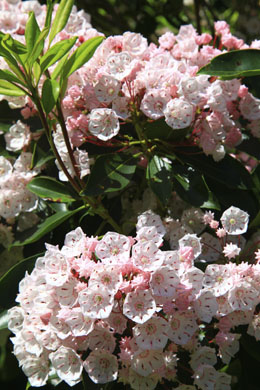Widely grown for ornamental purposes, mountain laurels have a showy green foliage and attractive spring flowers. Here are some tips for growing this plant properly.

Mountain laurel plants are evergreen shrubs, that are natives to the mountainous regions of the eastern United States. Related to rhododendrons and azaleas, the mountain laurel is also a member of the family
Ericaceae, but this shrub belongs to the genus
Kalmia. The scientific name of the species is
Kalmia latifolia.
This plant is also known in many other names, like spoon wood (as the Native Americans used to make spoons from the wood of this plant), ivybush, sheep laurel, calico bush, lambkill, and clamoun. Around 80 cultivars of mountain laurel shrub are available today, and they are grown for ornamental purposes. These plants are perfect for hedges, as accent plants, or as borders.
Features
Mountain laurels grow upright to a height of four to ten meters. The tough and glossy green leaves have a length of around 5 to 12 centimeters, and a width of up to five centimeters. The buds develop in clusters during the late fall, and the flowers emerge during the spring. The beautiful clusters of flowers may vary in color in different cultivars. The color of the flowers may range from white, pink, red, maroon, cream, and peach. Some of the cultivars produce flowers in mixed shades. It is the state flower of Pennsylvania and Connecticut.
Almost all parts of this plant are found to be toxic, and so, ingestion is not recommended. In case of accidental ingestion, seek medical attention immediately. However, household pets, like dogs and cats are not found to be affected with the toxicity of this plant.
Mountain Laurel Plant Care
Growing this plant is not a difficult task, as it requires minimal care only. However, there are certain basic requirements that have to be met, so that the plant grows healthy and produce blooms.
- Some people transplant these plants from the wild. It is always better to get a healthy plant from the nursery, as transplanting may damage its fragile root system. Get the right type of plant, as per your choice.
- Choose the ideal location for growing the plant. Mountain laurels prefer locations with partial shade. While full sun may dry out the roots, full shade is also not advisable, if you are growing this plant for flowers.
- These plants love acidic, moist, and well-drained soil. So add humus, peat moss, and sand, so as to make it ideal for planting mountain laurel shrubs. Once the soil preparation is done, plant the shrub. The roots should not be deep inside the soil.
- Make sure that the crown (where the plant stem meets the root) of the plant is just above the soil surface. If the crown is planted deep inside the soil, the plant may develop rot that may lead to its death.
- Regular watering is needed, till the plant establishes itself. After that, reduce the frequency of watering, but make sure to keep the soil moist. Feeding can be done in very small amounts, during the early spring or late fall. It will be better to use a slow release fertilizer for this purpose.
- Mulching is good for retaining moisture. However, make sure that the mulch, once decomposed, adds to the acidity of the soil, and not vice versa. Use pine needles or wood chips for mulching these plants.
- Mountain laurels are slow-growing plants that require minimal pruning, which include removal of seed heads during the flowering season. This improves the rate of flowering, the next year. Pruning is also good for maintaining the height of the plant.
So, get a mountain laurel of your choice, and grow it in your garden. You may contact a horticulturist or the local nursery authorities, for more details about growing mountain laurel shrubs.






 Mountain laurel plants are evergreen shrubs, that are natives to the mountainous regions of the eastern United States. Related to rhododendrons and azaleas, the mountain laurel is also a member of the family Ericaceae, but this shrub belongs to the genus Kalmia. The scientific name of the species is Kalmia latifolia.
Mountain laurel plants are evergreen shrubs, that are natives to the mountainous regions of the eastern United States. Related to rhododendrons and azaleas, the mountain laurel is also a member of the family Ericaceae, but this shrub belongs to the genus Kalmia. The scientific name of the species is Kalmia latifolia.